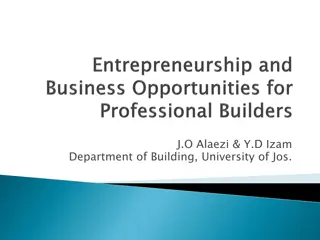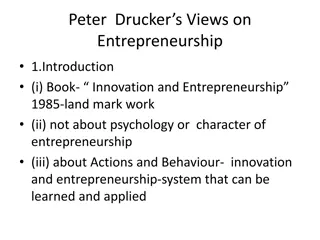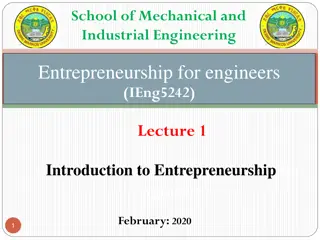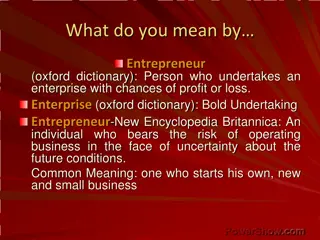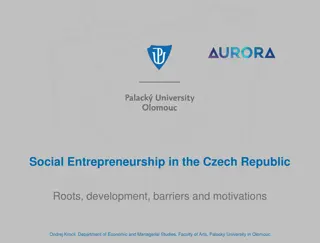Exploring Modern Entrepreneurship Trends: Incubators, Accelerators, and Opportunities
Discover the evolving landscape of entrepreneurship with a focus on business incubators and accelerators. Learn about their role in supporting startups, the difference between angel investors and incubators, and the benefits of engaging with these entities to elevate your entrepreneurial journey.
Download Presentation

Please find below an Image/Link to download the presentation.
The content on the website is provided AS IS for your information and personal use only. It may not be sold, licensed, or shared on other websites without obtaining consent from the author. Download presentation by click this link. If you encounter any issues during the download, it is possible that the publisher has removed the file from their server.
E N D
Presentation Transcript
The Dynamic New Trends of Entrepreneurship
Accelerators and Incubators INCUBATOR a business incubator is a company that helps new and start up companies to develop by providing services such as management training or office space. Basically they help new startup to perform better and grow better with help of knowledge and experience with brand name.
NBIA National Business INCUBATION Association NBIA defines business incubators as a catally st tool for either regional or national economic development. Types of Incubator: 1) Academic Institutions 2) Non- profit development corporations 3) for profit property development ventures 4) Venture capital firms 5) Combination of the above
Advantage Step 1 pitch and Join : Find for Incubator and see the best time to approach Now Get- and Give Get Advisory and give Be Aware and Analyze hit mil stone to analyze are going in right direction or not Last you move forward
Difference between Angel Investor and Incubator Angel Investors are wealthy individuals or groups of individuals who invest money or equity financing in start-up or early- stage small businesses. They are investors who usually provide private equity or second round funding for growing, profitable small businesses who need money to continue to grow.
knowledge There are so many Government Incubator available in basic amount To provide Advisory and Resources Find a Incubator who is in a particular Niche for best support Consider the financial structure of an Incubator Most Incubator are structured to get you to a point of formal funding It totally depends upon the deals
ACCELERATOR A business Accelerator is a program gives developing companies access to mentorship, Investors and other support that help them become stable, self-sufficient business, companies that use business Accelerators are typically start ups that have moved beyond the earliest stages of getting established. IDEA + ENTREPRENEURSHIP+ INCUBATION =BUSINESS
INCUBATOR PROS Mentorship to avoid mistake Ease of funding Valuable Network and connections They provide several services : Help with business basics Networking activities, Marketing assistance, Marketing research, High speed Internet access, Help with accounting and financial management, Access to bank loans, loans funds and guarantee programs. Help with presentation skill Links to higher education resources Links to strategic partners
continue Access to angel investors or venture capital comprehensive business training programs Advisory boards and mentors Management team identification Help with business etiquette Technology commercialization assistance Help with regulatory compliance Intellectual property management
Early stage business can consider incubator and accelerator programs as a funding option. These programs assist hundreds of startup business every year. These two are generally used interchangeably. However, incubator is like a parent who nurtures the business (child) whereas, accelerator helps to run or take a giant leap in business. Incubators and Accelerators ably connect the startups with mentors, investors and fellow startups using this platform.
2. Emerging Trends in Entrepreneurship: Startup accelerators Student Sandbox and Business Lab Crowd Funding Coworking spaces Entrepreneurship Degree 08/26/18 Copy right reserved 2 3. Startup accelerators This concept was not even in our vocabulary a few years ago, and now startup accelerator programs are popping up all over the country. Often privately funded and mostly used by tech startups, these accelerators help companies with the strongest potential of success obtain funding in exchange for equity. 08/26/18 Copy right reserved 3
Engineering from the perspective field Innovative ideas - innovators Social and Infrastructural changes 1) Startup India is a revolution scheme that has been started to help the people, who want to start their own business. 2) These people have ideas and capability so government will give them support to make sure they can implement their idea & grow. 3) Success of this scheme will eventually make India, a better economy and a strong nation
4. It is working towards innovation, development, and commercialization of new products, processes, or services driven by technology or intellectual property. 5. Provided that such entity is not formed by splitting up or reconstruction, of a business already in existence. Provided also that an entity shall cease to be a Start-up if its turnover for the previous financial years has exceeded INR 25 crore or it has completed 5 years from the date of incorporation/ registration. Provided further that a Startup shall be eligible for tax benefits only after
6. The entity is registered under Companies Act, 2013 It is registered under section 59 of Partnership Act 1932, as a partnership firm Or registered under Limited Liability Partnership Act, 2002, as a limited liability partnership firm 7. What is Inter Ministerial Board In order to obtain tax benefits, one has to obtain a certificate from the Inter- Ministerial Board of certification. The board consists of the following: Joint Secretary, Department of Industrial Policy and Promotion. Representative of Department of Science and Technology. Representative of Department of Biotechnology.
8. Startup to be considered eligible, the Startup should Be supported by an incubator which is funded (in relation to the project) from Govt. Of India(GOI) as part of any specified scheme to promote innovation; or Be supported by a recommendation (with regard to innovative nature of business), in a format specified by DIPP, from an Incubator recognized by GOI; or Be funded by GOI as part of any specified scheme to promote innovation; or Have a patent granted by the Indian Patent and Trademark Office in areas affiliated with the nature of business being promoted. 9. Quick analysis of the eligibility criteria
10. Why Startup India? To Boost up/ promote Startup/ Entrepreneurship To Boost up Banking Sector/ Finance To Limit State Policy Dependency for New Businesses To promote ST/SC Women Entrepreneurship Core objective is to generate maximum Employment Encourage the people who have the potential to innovate and start their own business.
STUDENT SANDBOX & BUSINESS LABS THE SANDBOX INNOVATION FUND PROGRAM CONNECTS STUDENTS with tailored educational experiences, mentoring, and seed money to help qualified students and teams nurture their ideas and creativity. Launched in January 2016, Some institutions Sandbox is an Institute-wide program led by the School of Engineering in partnership with the Institute Innovation Initiative. The primary aim of Institute Sandbox is to develop people, not startups or products,
Sandboxes are collaborative collision spaces hosted by universities that bring together students, mentors, and external advisors to take business and social enterprise concepts from ideation to execution. They act as hubs and are designed to help leverage the human resource and research capacity in the province s universities and colleges to create changes in knowledge, skills, and attitudes (KSA), and knowledge-based businesses or social enterprises, while also providing new educational opportunities for students.
focus of this initiative is to enable Nova Scotia to leverage and grow the province s innovation ecosystem and help support entrepreneurs in understanding business and potentially creating both start-ups and social enterprises. Over two weeks students participate in an immersive, full-time experience that introduces them to a suite of approaches, tools, and mindsets that unleash their creative potential and amplify their capacity for innovative problem solving.
At the core of the program is design thinking, also referred to as human-centred design. Through interactive workshops, learning games, independent experimentation, and exploring the world outside the classroom, participants apply their design thinking skills to a central design challenge that tackles an issue facing Nova Scotia communities. A central feature of these pilots has been their focus on encouraging and fueling the innovation ecosystem through efforts to boost entrepreneurship within universities and among a broad range of key stakeholders including students, young professionals, business, and industry, among others.
Student Sandbox and Business Lab More Universities are developing student sandboxes on and off their campuses to support student startups. Sandboxes operate like business incubators except that they are more focused on developing and mentoring student startup teams and are often tied into some type of entrepreneurship degree program or course. Student Sandbox and Business Lab Many sandbox programs provide students with the opportunity to win seed money, grants, business services and receive coaching and mentorship from successful startup founders. Some examples include Student Sandbox, Student Startup and Venture Lab
Objective is to reduce the regulatory burden on Startups thereby allowing them to focus on their core business and keep compliance cost low. Regulatory formalities requiring compliance with various labour and environment laws are time consuming and difficult in nature. Often, new and small firms are unaware of nuances of the issues and can be subjected to intrusive action by regulatory agencies. In order to make compliance for Startups friendly and flexible, simplifications are required in the regulatory regime. Startups shall be allowed to self-certify compliance (through the Startup mobile app) with 9 labour and environment laws. In case of the labour laws, no inspections will be conducted for a period of 3 years. In case of environment laws, only random checks would be carried out. 1. Compliance regime based on self certification Startup India:
2. Startup India hub A startup India hub will be created as a single point of contact for the entire startup ecosystem to enable knowledge exchange and access to funding. The Startup India Hub will be a key stakeholder in this vibrant ecosystem and will: Work in a hub and spoke model and collaborate with Central & State governments, Indian and foreign VCs, angel networks, banks, incubators, legal partners, consultants, universities and R&D Institutions. Assist Startups through their lifecycle with specific focus on important aspects like obtaining financing, feasibility testing, business structuring advisory, enhancement of marketing skills, technology commercialization and management evaluation. Organize mentorship programs in collaboration with government organizations, incubation centers, educational institutions and private organizations who aspire to foster innovation.
3. Simplifying the startup process A startup will be to able to set up by just filling up a short form through a mobile app and online portal. A mobile app will be launched on April 1 through which startups can be registered in a day. There will also be a portal for clearances, approvals and registrations. Towards these efforts, the Government shall introduce a Mobile App to provide on-the- go accessibility for: Registering Startups with relevant agencies of the Government. A simple form shall be made available for the same. The Mobile App shall have backend integration with Ministry of Corporate Affairs and Registrar of Firms for seamless information exchange and processing of the registration application. Tracking the status of the registration application and anytime downloading of the registration certificate. A digital version of the final registration certificate shall be made available for downloading through the Mobile App. Filing for compliances and obtaining information on various clearances/ approvals/ registrations Required.
4. Patent protection The government is also working on a legal support for fast-tracking patent examination at lower costs. It will promote awareness and adoption of Intellectual Property Rights (IPRs) by startups and help them protect and commercialize IPRs. Various measures being taken in this regard include: Fast-tracking of Startup patent applications: The valuation of any innovation goes up immensely, once it gets the protective cover of a patent. To this end, the patent application of Startups shall be fast-tracked for examination and disposal, so that they can realize the value of their IPRs at the earliest possible. Government to bear facilitation cost: Under this scheme, the Central Government shall bear the entire fees of the facilitators for any number of patents, trademarks or designs that a Startup may file, and the Startups shall bear the cost of only the statutory fees payable. Rebate on filing of application: Startups shall be provided an 80% rebate in filing of patents vis- -vis other companies. This will help them pare costs in the crucial formative years. The scheme is being launched initially on a pilot basis for 1 year, based on the experience gained, further steps shall be taken.
5. Funds of funds with a corpus of Rs 10,000 crore In order to provide funding support to startups, the government will set up a fund with an initial corpus of Rs 2,500 crore and a total corpus of Rs 10,000 crore over four years. The fund would be managed by private professionals drawn from the industry while LIC will be a co- investor in the fund. The Fund of Funds shall contribute to a maximum of 50% of the stated daughter fund size. In order to be able to receive the contribution, the daughter fund should have already raised the balance 50% or more of the stated fund size as the case maybe. 6. Credit Guarantee Fund A National Credit Guarantee Trust Company is being envisaged with a budgetary allocation of Rs 500 crore per year for the next four years. 7. Exemption from Capital Gains Tax Currently, investments by venture capital funds in startups are exempt from this law. Now, the same is being extended to investments made by incubators in startups.
6. Tax exemption for startups Income tax exemption to startups announced for three years. Innovation is the essence of every Startup. Young minds kindle new ideas every day to think beyond conventional strategies of the existing corporate world. During the initial years, budding entrepreneurs struggle to evaluate the feasibility of their business idea. Significant capital investment is made in embracing ever-changing technology, fighting rising competition and navigating through the unique challenges arising from their venture. With a view to stimulate the development of Startups in India and provide them a competitive platform, it is imperative that the profits of Startup initiatives are exempted from income-tax for a period of 3 years. This fiscal exemption shall facilitate growth of business and meet the working capital requirements during the initial years of operations. The exemption shall be available subject to non- distribution of dividend by the Startup.
7. Tax exemption on investments above Fair Market Value Under The Income Tax Act, 1961, where a Startup (company) receives any consideration for issue of shares which exceeds the Fair Market Value (FMV) of such shares, such excess consideration is taxable in the hands of recipient as Income from Other Sources. In the context of Startups, where the idea is at a conceptualization or development stage, it is often difficult to determine the FMV of such shares. In majority of the cases, FMV is also significantly lower than the value at which the capital investment is made. This results into the tax being levied under section 56(2) (viib).
8. Startup fests Innovation core programs for students in 5 lakh schools. There will also be an annual incubator grand challenge to create world class incubators. As part of Make in India initiative, Government proposes to: Hold one fest at the national level annually to enable all the stakeholders of Startup ecosystem to come together on one platform. Hold one fest at the international level annually in an international city known for its Startup ecosystem. 11. Launch of Atal Innovation Mission Atal Innovation Mission started to give an impetus to innovation and encourage the talent among the people. The Atal Innovation Mission (AIM) shall have two core functions: Entrepreneurship promotion through Self-Employment and Talent Utilization (SETU), wherein innovators would be supported and mentored to become successful entrepreneurs. Innovation promotion: to provide a platform where innovative
9. Innovation focused programmes for students There will be innovation core programs for students in 5 lakh schools. In order to promote research and innovation among young students, the Government shall implement the following measures: Innovation Core. Innovation Core program shall be initiated to target school kids with an outreach to 10 lakh innovations from 5 lakh schools. One lakh innovations would be targeted and the top 10,000 innovations would be provided prototyping support. Of these 10,000 innovations, the best 100 would be shortlisted and showcased at the Annual Festival of Innovations in the Rashtrapati Bhavan.
NIDHI: A Grand Challenge program (National Initiative for Developing and Harnessing Innovations) shall be instituted through Innovation and Entrepreneurship Development Centres (IEDCs) to support and award INR 10 lakhs to 20 student innovations from IEDCs. Uchhattar Avishkar Yojana: A joint MHRD-DST scheme which has earmarked INR 250 crore per annum towards fostering very high quality research amongst IIT students. The funding towards this research will be 50% contribution from MHRD, 25% from DST and 25% from industry. This format has been devised to ensure that the research and funding gets utilized bearing in mind its relevance to the industry. Each project may amount to INR 5 crore only. This scheme will initially apply to IITs only.
How to Register with Startup India Scheme In the official notification which is issued by the govt in that said startups have first of all register their business as Legal entity as Private limited company, Limited Liability Partnership or Partnership Firm, then they have to register through a mobile app or through the portal of DIPP(Department of Industrial Policy and Promotion)
Documents Required for Startup India Have to Submit Application along with any Below Documents :- A recommendation in a format specified by DIPP from an incubator established in a post-graduate college in the country. A letter of support from any central or state government funded incubator to promote innovation. A recommendation in a format specified by DIPP (with regard to innovative nature of business) from any incubator recognized by the Central Government. A letter of funding of not less than 20 per cent in equity by any incubation or angel fund/PE fund/accelerator or angel network duly registered with Securities and Exchange Board of India that endorses its innovative nature of business. A letter of funding by the Central or State government as part of any scheme to promote innovation. A patent filed and published in the Journal by the Indian Patent Office in areas affiliated with the nature of business being promoted.
WHAT IS CROWDFUNDING? Crowd funding is a method of getting finance by sourcing small amounts from a relatively large number of people rather than getting large amounts from one or a few. Online crowd funding allows individuals or organizations to source funds from anyone via a website or crowd funding platform by social media.
Crowd funding is described as the practice of funding a project or venture by raising money from a large number of people (the crowd) who each contribute a relatively small amount, typically via the Internet. Most crowd funding campaigns are run on websites called platforms. Most platforms charge a fee based on the sum raised by the campaign. Some platforms like Kickstarter and Indiegogo have become so well known that their names are often used to describe the act of running a crowdfunding campaign, so I am going to do a Kickstarter means I am going to run a crowdfunding campaign.
CONS Time consuming Stressful Can be expensive once you take into account fees, rewards costs, your own time Reputational risk associated with potential failure to meet fundraising target, or worse failure to deliver project & rewards PROS Money for your project Learn who is interested in and will support your work (might surprise you) Start building philanthropic relationships and gathering data about supporters An opportunity for a big marketing campaign & the benefits that can bring
MORE TIPS MAKE THE CAMPAIGN LOOK SUCCESSFUL WHEN YOU GO PUBLIC: Have a 3 day soft launch before you promote the campaign & get your close friends, family & core supporters to pledge during that time KEEP THE CAMPAIGN FRESH & DYNAMIC DURING THE SLUMP : Plan new reward tiers to release during the 2 week quiet period in the middle, and publish behind-the-scenes content to maintain interest
BASICS Crowdsourcing in Different Variations Crowdsourcing: The process of using knowledge, skills and other resources from a large group of people Crowd creation: Crowds creatively work together on projects, ideas, designs and concepts on a particular topic. Crowd voting: Crowds rate and share opinions and recommendations. Example: customer reviews on Amazon or Apple Crowd sharing: More commonly known as sharing economy, collaborative consumption or peer economy, this is when crowds share access to goods and services.
APPROACH A Successful Crowd funding Project in 10 Steps 1. Select crowd funding model 2. Select platform 3. Set target amount 4. Choose compensation 5. Give the story behind the idea 6. Learn from others 7. Have the right mindset 8. Make the start of the campaign count 9. Gain supporters from the crowd 10. Establish individual approach
1 1. Select Crowd funding Model. It is important to select the appropriate crowd funding model. Use the right model to reflect your motivation and determine what type of return the crow d will receive. There are four crowd funding models: It is also possible to combine these models. Reward-Based Crowd funding Equity-Based Crowd funding Lending-Based Crowd funding Donation-Based Crowd funding 12. APPROACH A Crowd s Motives for Investing TO RECEIVE Reward-Based Crowd funding TO EARN Crowd investing TO SUPPORT Donation-Based Crowd funding 13. APPROACH Step 2 2. Select Platform Due to its large scope, crowd funding predominantly takes place on the Internet. After choosing the best model, the next step is choosing the appropriate platform. Specialists Platforms Generalists Platforms Regional National International By type By place 14. APPROACH Step 3 3. Set target amount Most crowd funding platforms operate on the "all-or-nothing basis. Initiators specify a target sum and if this is reached, they receive the money to finance their projects. If the target amount is not reached, the initiators get nothing and the crowd gets their money back. Realistic Covers Costs Project-Based The target sum should be as realistic as possible to ensure it can be met. This amount should cover all costs of realizing the project. It is wise to disclose the gross cost of the project in order to provide transparency and trust.
How does crowd funding work? The basic principle is that you set a target sum to raise and a timeframe within which to do it. You then place your project on a publicly available platform and encourage people to visit the page through an active and planned outreach programme using tools like social media and email. For example, if a project receives in-kind support from a business supporter then the target can be raised or amended to reflect that. Or if a crowd fund is really successful in the first few days after being launched a group might want to raise their fundraising target to allow the project to achieve more than the original aim3
What are the different types of crowd funding? Debt, Equity Rewards Donation There are four types of crowd funding. These are: Donation base Reward base- non financial Lending as a security minimum 5% invest 20000 to 60000 maximum 200 investors Equity - Shares, or other types of financial instruments like bonds, are sold in small parcels to a large group of investors. (illegal in India) Upfront investment scale: Early stage growth 1 to 3 years Growth stage - 3 to 6 years Late stage growth -- 6 + years
Why is crowd funding growing? Making a public call to fundraise from the crowd is not a new idea but crowd funding as we now understand it has grown very quickly for a number of reasons since its emergence in the 1990s. These include: Technological developments Societal changes Economic factors -
What makes crowd funding different from other funding? Crowd funding reaches widely by using technology and reduces the size of funding each individual contributor has to come up with. This means that more people can take part. Making it easy for a wider group of people to support a business or project introduces a wider range of motivations for people to back a campaign. This means that there is a range of reasons why people might support you, and not simply for a financial return. The idea of many small contributions making a difference (as opposed to a small number of large contributions) is a concept underpinning lots of online activities which have disrupted traditional industries and it is called The Long Tail .
Advantages & disadvantages of crowdfunding As with all forms of fundraising, there are advantages and disadvantages. What are the advantages? It is a very accessible process which is open to all and can be carried out on your terms you decide on the amount you want to raise and the timescale to raise the funds. You are in control the promotion and selling of the project is the responsibility of your group. It can bring much more than money it can attract new people and support (non-financial) to your group. What money it does bring can be very different from traditional investment funds raised through crowd funding are unrestricted and can be used for all elements of your project. It can be quick as you are in control you are able to work quickly to start raising funds.
What are the disadvantages? It is not easy to be a success takes a lot of time and effort to carry out continued promotion of your campaign. Many campaigns are unsuccessful and the successful ones take work, preparation and effort to make them happen there is no guarantee of success but work, preparation and effort can increase the chances of success. It is also a very public process and so you must be prepared to be open and honest in a public arena and expect brickbats and bouquets in equal measure it is important to accept that there may be public scrutiny of your project and prepare for this.





